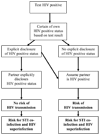A strategy for selecting sexual partners believed to pose little/no risks for HIV: serosorting and its implications for HIV transmission
- PMID: 20024704
- PMCID: PMC2937200
- DOI: 10.1080/09540120902803208
A strategy for selecting sexual partners believed to pose little/no risks for HIV: serosorting and its implications for HIV transmission
Abstract
A common HIV/AIDS risk reduction strategy among men who have sex with men (MSM) is to limit their unprotected sex partners to those who are of the same HIV status, a practice referred to as serosorting. Decisions to serosort for HIV risk reduction are based on personal impressions and beliefs, and there is limited guidance offered on this community derived strategy from public health services. This paper reviews research on serosorting for HIV risk reduction and offers an evidence-based approach to serosorting guidance. Following a comprehensive electronic and manual literature search, we reviewed 51 studies relating to the implications of serosorting. Studies showed that HIV negative MSM who select partners based on HIV status are inadvertently placing themselves at risk for HIV. Infrequent HIV testing, lack of HIV status disclosure, co-occurring sexually transmitted infections, and acute HIV infection impede the potential protective benefits of serosorting. Public health messages should continue to encourage reductions in numbers of sexual partners and increases in condom use. Risk reduction messages should also highlight the limitations of relying on one's own and partner's HIV status in making sexual risk decisions.
Figures
References
-
- Blackard JT, Cohen DE, Mayer KH. Human immunodeficiency virus superinfection and recombination: current state of knowledge and potential clinical consequences. Clinical Infectious Diseases. 2002;34:1108–1114. - PubMed
-
- Butler DM, Smith AM. Serosorting can potentially increase HIV transmission. AIDS. 2007;21:1218–1220. - PubMed
-
- Cachay ER, Frost SD, Poon AF, Looney D, Rostami SM, Pacold ME, et al. Herpes simplex virus type 2 infection does not influence viral dynamics during early HIV-1 infection. Journal of Infectious Diseases. 2007;195:1270–1277. - PubMed
-
- Centers for Disease Control and Prevention. HIV/AIDS statistics and surveillance. 2007. http://www.cdc.gov/hiv/topics/surveillance/basic.htm#hivaidsexposure.
Publication types
MeSH terms
Grants and funding
LinkOut - more resources
Full Text Sources
Medical


